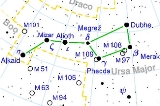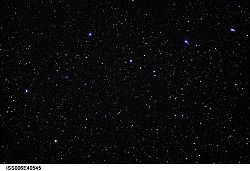
Horse and Rider
Encyclopedia

Asterism (astronomy)
In astronomy, an asterism is a pattern of stars recognized on Earth's night sky. It may form part of an official constellation, or be composed of stars from more than one. Like constellations, asterisms are in most cases composed of stars which, while they are visible in the same general direction,...
composed of the two stars Mizar
Mizar (star)
The Mizar–Alcor stellar sextuple system consists of the quadruple system Mizar and the binary system Alcor.- Description :Mizar is a quadruple system of two binary stars in the constellation Ursa Major and is the second star from the end of the Big Dipper's handle. Its apparent magnitude is 2.23...
(ζ UMa) and Alcor
Alcor
Alcor can refer to:* Alcor , also known as 80 Ursae Majoris, a star in Ursa Major very close to Mizar* Alcor Life Extension Foundation* Alcor sailplane, a high altitude pressurized sailplane developed by aeronautical engineer Robert Lamson...
(80 UMa) because of their close proximity in the sky. Mizar is the second star in from the end of the handle of the Big Dipper
Big Dipper
The Plough, also known as the Big Dipper or the Saptarishi , is an asterism of seven stars that has been recognized as a distinct grouping in many cultures from time immemorial...
. Mizar has apparent magnitude
Apparent magnitude
The apparent magnitude of a celestial body is a measure of its brightness as seen by an observer on Earth, adjusted to the value it would have in the absence of the atmosphere...
2.27 and spectral class A1 V. With good eyesight one can make out Alcor as a faint companion just to the east. Alcor has magnitude 3.99 and spectral class A5 V. The ability to see Alcor is said to have been used by the Arabs (who called it 'the lost or friendless one'), Romans, English, and other cultures to test warriors' eyesight.

Light-year
A light-year, also light year or lightyear is a unit of length, equal to just under 10 trillion kilometres...
s apart. While their proper motion
Proper motion
The proper motion of a star is its angular change in position over time as seen from the center of mass of the solar system. It is measured in seconds of arc per year, arcsec/yr, where 3600 arcseconds equal one degree. This contrasts with radial velocity, which is the time rate of change in...
s show they move together as members of the Ursa Major Moving Group
Ursa Major Moving Group
The Ursa Major Moving Group, also known as Collinder 285 or Ursa Major association, is a nearby stellar moving group, a set of stars with common velocities in space and thought to have a common origin. Its core is located roughly 80 light years away...
, it was not believed that they formed a true visual binary star system that interacts gravitationally, just an optical binary. However, in 2009, a detailed survey of the system revealed that not only was Alcor also a binary, bringing the total number of stars in the system to six (Mizar is actually a pair of binary stars), but that the entire system is gravitationally bound.http://www.sciencedaily.com/releases/2009/12/091210092005.htm

